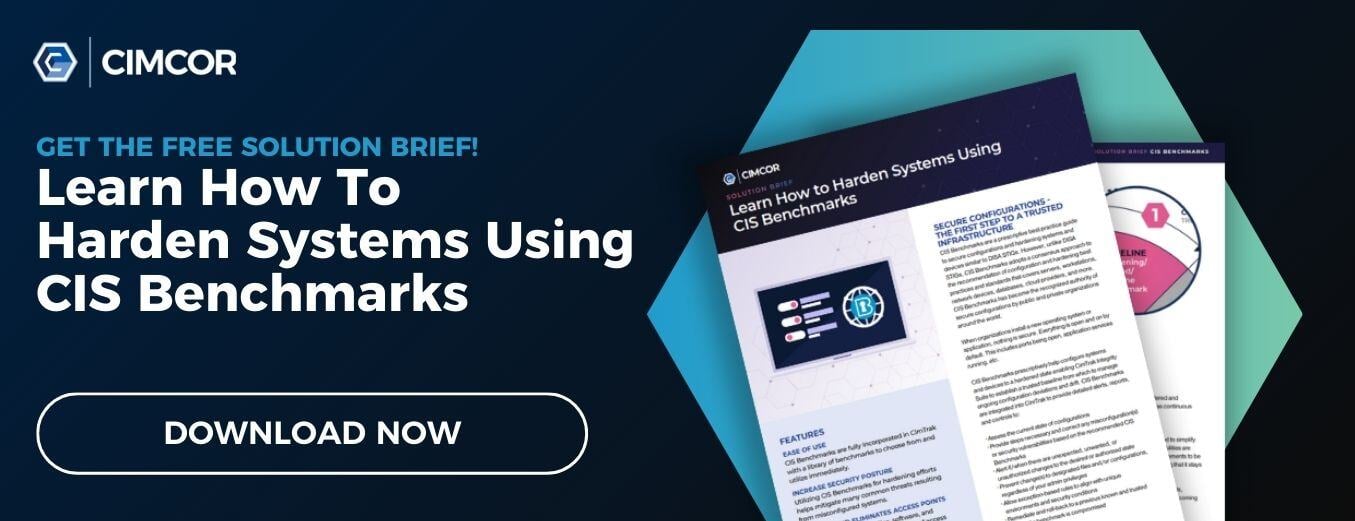Information security is all about maintaining certain standards and benchmarks. Of those standards, the CIS Benchmarks are one of the most common.
When you navigate to the CIS Benchmarks website, you may find yourself quickly overwhelmed as you may not be sure where to begin with system hardening. The site lists over a hundred standards associated with dozens of vendors. If you are unfamiliar with the standards, attempting to navigate through the site cold can make your head spin. If you have ever had trouble identifying or keeping track of the CIS Benchmarks relevant to your organization, tools, and industry, you have come to the right post.
This post will serve as your CIS Compliance Benchmark 101. We will cover the basics of the CIS Benchmarks and discuss three critical things you must know to maintain compliance.
CIS Benchmarks: The Basics
The compliance benchmarks discussed in this post come from CIS, the Center for Internet Security. Though they are not compulsory, the CIS Benchmarks serve as a set of widely recognized best practices that can help information security teams better manage cybersecurity.
CIS Benchmarks are recognized across the globe and are used across a wide variety of organizations and industries. These benchmarks cover best practices for hardware and software from over twenty-five different vendor families. The vendors covered in CIS benchmarks include:
- Microsoft
- Linux
- Amazon Web Services (AWS)
- Apple
- CentOS
- Check Point Firewall
- Cisco
- Debian
- Docker
- IBM
- Kubernetes
- Kerberos
- MongoDB
- Oracle
- Palo Alto
- Ubuntu
- VMWare
Related Read: CIS Awards Cimcor First-Ever Benchmarks Configuration Certification
Armed with this over-arching understanding of CIS Benchmarks, we are now ready to explore the critical elements you must understand to meet these benchmarks in your organization.
1. CIS Benchmark Levels
Before you can maintain compliance with your CIS Benchmarks, you must decide which level of benchmark your organization plans to strive for. There are three levels of CIS Benchmarks you may pursue:
- Level 1: These are the basic cybersecurity recommendations from CIS. These benchmarks are simple to apply quickly. The aim of striving for level one benchmarks is to minimize your attack surface while impacting your day-to-day operations as little as possible.
- Level 2: CIS’s second level of benchmarks involves a more in-depth defense strategy. Maintaining level two benchmarks communicates that security is a core value for your organization. This level is a good fit for companies maintaining data that would result in drastic consequences if breached.
- STIG: Formerly known as Level 3, this level follows STIG (Security Technical Implementation Guide) recommendations.
Once you have an understanding of the CIS Benchmark levels, you are ready to begin implementing your cybersecurity measures. To complete this, you will need to understand the CIS implementation groups.
2. CIS Implementation Groups
As much as you may want to incorporate all your new cybersecurity efforts at once, that is not possible. You must prioritize your efforts to implement the most vital changes first. This prioritization brings us to the CIS implementation groups.
- IG1: The first implementation group includes efforts related to basic cyber hygiene. These efforts will help you avoid non-targeted attacks, but will not be sufficient to defend against more sophisticated attacks.
- IG2: The second level of implementation includes measures that will help you maintain security throughout your organization. This group includes activities that can help address varying levels of risk.
- IG3: The final implementation group is the most robust of your cybersecurity measures. These measures are meant to secure sensitive, confidential, or protected data. The efforts you make here will help defend your business against more sophisticated attacks.
Moving sequentially through these three groups will strengthen your cybersecurity infrastructure and prepare you for the majority of attacks you could face. Next, let’s explore the connection between System Integrity Assurance and maintaining compliance with CIS Benchmarks.
3. System Integrity Assurance and CIS Benchmarks
Complying with CIS Benchmarks can feel overwhelming, but one way to set yourself up for success is to maintain system integrity assurance.
What is system integrity assurance? System Integrity Assurance is a process that works to identify, prohibit, and remediate unknown or unauthorized changes in real-time. When implemented properly, system integrity assurance measures empower your team to maintain a continuously compliant IT infrastructure in less time and with less effort.
System integrity assurance can help with system hardening efforts. CimTrak, our System Integrity Assurance solution, can help keep your systems hardened by leveraging best practices and assessing your infrastructure using the CIS framework.
Maintaining CIS Benchmarks
Maintaining compliance and following the CIS Benchmarks can feel intimidating, but with the right processes and systems in place, it does not have to be. Armed with this understanding of the various levels and implementation groups associated with CIS Benchmarks, you should have a solid foundational knowledge of the subject.
Additionally, with this understanding of System Integrity Assurance, you should have everything you need to not only comply with CIS Benchmarks but also use the resulting processes and practices to the maximum extent possible regarding your organization’s cybersecurity.
For more information regarding CIS Benchmarks, explore our free resource, the CIS Benchmarks Solutions Brief.
Tags:
Compliance
September 24, 2024




